The Baltics: September 2006
The Baltics (Estonia, Latvia, Lithuania) and Poland: September 2006
We went with Gate1 Travel on a guided tour. Though we were on a group tour, we had plenty of leisure time scheduled, so we used two guidebooks, “Lonely Planet Estonia, Latvia, and Lithunia” which had just been issued in June 2006. As usual, the maps were very good and most of the information is accurate. We also had the 2006 edition of the “Bradt Guide: Baltic Capitals” which is very good. The maps aren’t as good as Lonely Planet, but the information is better. For Poland we used “Lonely Planet Poland” and “Rough Guide Poland”. Things are changing so rapidly there that both of the guides were outdated for certain things though the most recent editions for both were published in 2005.
30 Sept. 2006
Arrived to Tallinn, Estonia on Lufthansa with slightly rainy weather. True to the reviews on TripAdvisor, our Meriton Grand Hotel had a very smoky lobby and Souza the bellman was really friendly and attentive. Otherwise, the hotel is good though just on the edge of the city. Our room was very quiet, and the bathroom was on the small side but very clean.
We walked uphill on Toompea Road to get into the center, and the road was under renovation and our first sign of the tremendous amount of construction going on throughout the region. We viewed the large medieval wall and the tall Herman’s Tower and Toompea Castle.
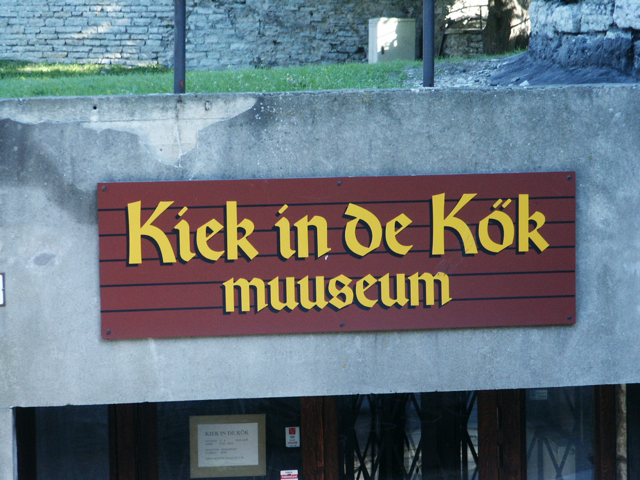 Our timing was good since we arrived to Alexander Nevsky Cathedral, the Russian Orthodox cathedral, during a service. People were crossing themselves many times upon entering and exiting the church. Inside people were kissing statues and icons at various stations, and many people stood in line to make confession to one of the priests (no booth like in a Roman Catholic setting but rather face to face confession). All women, young and old, were wearing scarves, so my wife felt a bit conspicuous without one. There was also a younger priest chanting prayers.
Our timing was good since we arrived to Alexander Nevsky Cathedral, the Russian Orthodox cathedral, during a service. People were crossing themselves many times upon entering and exiting the church. Inside people were kissing statues and icons at various stations, and many people stood in line to make confession to one of the priests (no booth like in a Roman Catholic setting but rather face to face confession). All women, young and old, were wearing scarves, so my wife felt a bit conspicuous without one. There was also a younger priest chanting prayers.
We continued walking down through the rain-soaked cobblestone streets to town.
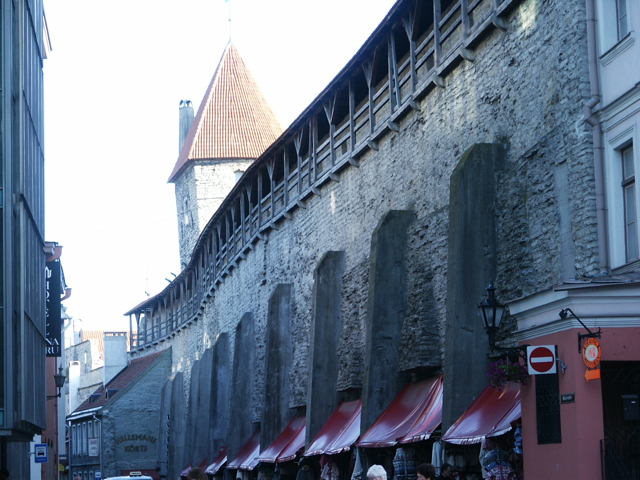
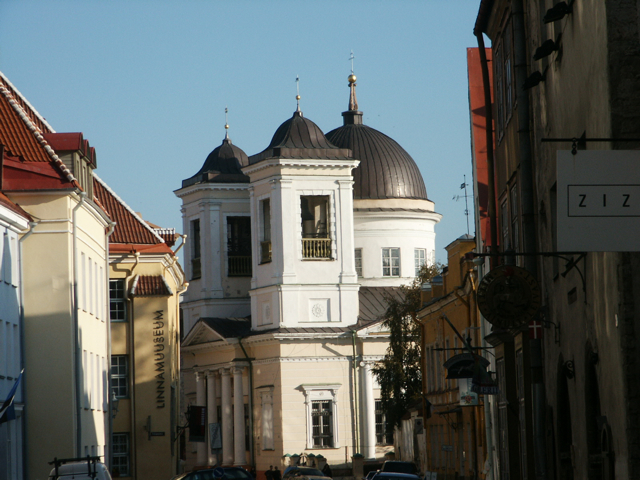
We walked into the popular pub “Hell Hunt” (translates to “Gentle Wolf”), which claims to be Tallinn’s 1st pub (as opposed to oldest pub or first Irish pub, etc. – Estonians like superlatives).
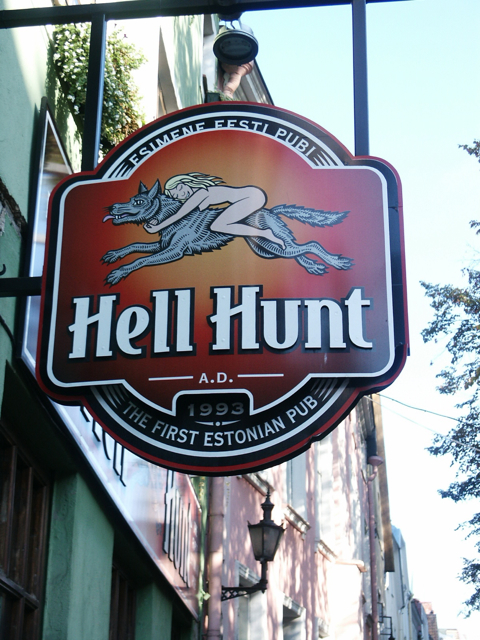
We enjoyed the inebriated British yobs in the window of a karaoke bar, not dissimilar from the types we’ve seen in Amsterdam (ah, the joys of cheap intra-European flights). We had delicious hot chocolate and truffles at 30 Pikk Street, Annaliki. We reluctantly accepted flyers being distributed by attractive young women fearing them to be invites to red light type sites, but fortunately they turned out to also be in English and advertising “Design Night,” which that night happened to be. So a few museums and galleries were open late and free of charge. We viewed the Estonian Museum of Applied Art, in an interesting building with the permanent collection of particular interest (some Deco and Arts & Crafts pieces) http://www.etdm.ee/. Prices to buy things in galleries are pretty much on a par with Western Europe.
At a vista point along the stone walls we saw local youth congregating, drinking, making out, and even urinating. They were fairly civilized, though, despite the many empty bottles of alcohol around. The city is very clean and well lit.
1 October 2006
Breakfast buffet about what we expected with deli meats, hot dogs, an egg soufflé and other things, and very crowded. First stop was the Museum of Occupation, documenting the history of Estonia from Nazi Germany through the demise of the Soviet Union. The smallest museum of its type in the regions, but still quite interesting. The statues of former Communist officials that have been put to rest in the basement are particularly interesting, including a bust of Lenin. Larger items featured included an old Volga automobile and a refugee boat used to transport people to Sweden. The main floor is lined with old suitcases from the 1930’s-1950’s. Lots of information in English. http://www.okupatsioon.ee/english/index.htm Admission is 10 EEK, and the museum has a small and reasonably-priced café.
Next stop is the deconsecrated St. Nicholas Church (also known as the Niguliste Museum, http://www.ekm.ee/eng/niguliste.php, 35 EEK admission, a branch of the Art Museum of Estonia). It still looks like a church and hosts concerts now and is open as a museum. The statues, furniture, and pulpit were spared during WWII though the church was bombed. The most famous work in the museum is the large panel painting, the Danse Macabre, which reminds us that the dance of death escapes no one, rich or poor, bishops or sinners… (read more and view a photo: http://en.wikipedia.org/wiki/Danse_Macabre).
Another branch of the museum is the Adamson-Erik Museum (as is their custom the last name comes first; http://www.ekm.ee/eng/adamson.php, admission 20 EEK). Adamson was one of Estonia’s best known artists whose work included many beautiful pieces of applied arts, like jewelry and the leather book covers that seem so popular in the Baltics. His paintings have a strong Picasso influence (blue, cubist, etc.). We were very lucky that the special exhibit when we visited was “From Design to the Costume: Estonian National Opera 100,” celebrating 100 years of costume design. There were beautiful watercolors and drawings for elaborate costumes and many costumes themselves. A friendly guide led us downstairs to see even more, though she spoke no English. Most of the costumes are embroidered, but often the designs are painted on, or they use shells, buttons, or faux gems.
Bad lunch at Pizza Americana. Don’t know when we’ll learn not to rely on dining recommendations from Lonely Planet.
Afternoon consisted of a walking tour with a guide. Annabella went off on her own to explore a couple of additional small museums and churches on her own, and she stumbled upon the small Church of the Holy Spirit (Puhavaimu Kirik), the church with the beautiful 17th century azure clock on its outer wall, and a service in English and soothing organ music. The walking tour took us to the Tallin Song Bowl where in September 1988 more than 200,000 people demanded independence in the “Singing Revolution.” Along the way are many grim reminders of the Soviet era in the form of hideous block apartment buildings in poor shape. Tour guide said that there is high crime in Tallinn, and it is clear that the Russians are not at all well-liked. The lawyer sitting next to us on the plane also implied that there are some outstanding border issues. The tour ended in the city center at the “Cat Well,” where cats and other animals were drowned in an effort to appease evil spirits to the point where the city’s water supply was poisoned by all the rotting carcasses.
Dinner was at the large PepperSack restaurant (named for a former mayor but with a big red bag hanging in the front, located centrally at Viru Tanav 2, www.peppersack.ee). Of course the food was only mediocre. The strangest part of the dinner was the “entertainment.” Men dressed is some kind of historic costume doing a “comedy sketch” that consisted of some fake punches and some weird jokes. This was followed by a belly dancer. Is that Estonian in any way? Very strange and stupid.
2 October 2006
Long bus ride to Riga, Latvia. Stopped at a shopping complex for lunch. We spent too much time wandering around the large supermarket and checking out the merchandise and ended up with not quite enough time to eat. We went to Hessburger, which seems to be a small chain. Not exactly “fast” food, though they got the meal combo concept down. We got a mini meal which was, indeed, mini. Dinner at the hotel in Riga was unmemorable – salad, salmon, ice cream.
Hotel is the German chain Maritim. Very clean and well-maintained hotel with free Internet access (though only 2 computers) and clean, quiet, comfortable rooms. The hotel is on the “other” side of the Daugava River, so it is not too convenient for sightseeing. If you like to walk and the weather is good, it’s probably just over a mile to the other side. The trams run in front of the hotel, but they seemed crowded and chaotic (all the guidebooks confirmed this). This is a huge conference hotel but wasn’t too busy during our stay.
3 October
Buffet breakfast is typical for the region (sugar water juice, deli meats, yogurt, odd tasting eggs, but good rye bread).
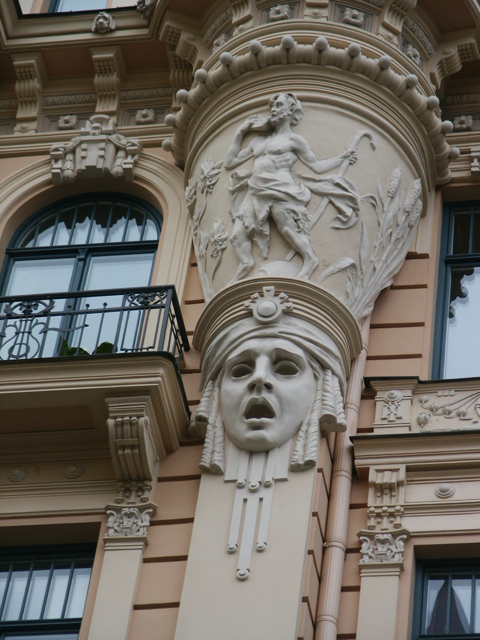
Morning tour started in the Art Nouveau district. Many artful buildings with ornamental facades and bright colors.
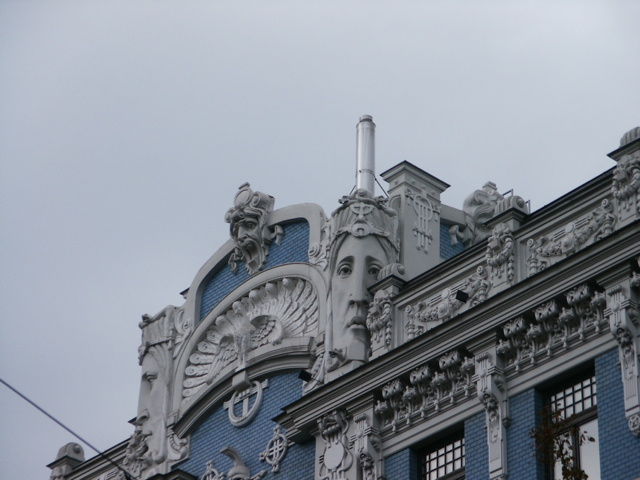
We went to the Museum of Occupation, focusing on the years 1940-1991 and largely financed by Latvian-Americans. The museum is much larger and more detailed than the Tallinn museum, and it is free and has English translations of most exhibits (http://www.occupationmuseum.lv). There appear to be old people there to tell their personal stories (like at the Holocaust Museum in D.C.), but here is where the language barrier is a big problem. The model of the Gulag barracks was particularly disturbing, especially the toilet called pratash, which was a metal drum with sharp edges with only (and only occasionally) a wooden plank for comfort. Prisoners lived a life similar to a concentration camp. The museum has many items made by survivors (items like rosaries with beads made of rolled up bread).
We enjoyed the Museum of Decorative Arts and Design (http://www.muzeji.lv/guide/pages_e/dekorativmakslas.html; separate admission prices for different parts of the museum). We visited the permanent collection but found we could see the special glass exhibit from the top floor because the center of the museum is an atrium style. The wooden framework architecture of the museum is almost as interesting as the artwork. Lots of Art Nouveau items and beautiful wood and ceramics.
Lunch at Pelmeni XL, which is cheap and popular with students and conveniently located inside of the old town galleria. Luckily those students generally speak English and they were happy to translate the contents of large containers of pelmeni (filled dumplings, like pierogi). You self-serve from a wide variety of options in soup tureens and into your bowl. You can add toppings and then pay by weight. Lunch for 4 with a couple of drinks (small portions) was about $10. Cash only. We walked around more and then ended up with a rest at a branch of the chain Double Coffee, which was surprisingly pretty good. I had French press coffee while my wife had strawberry hot chocolate served in a martini glass (very thick). We also shared some good mushroom and cream crepes.
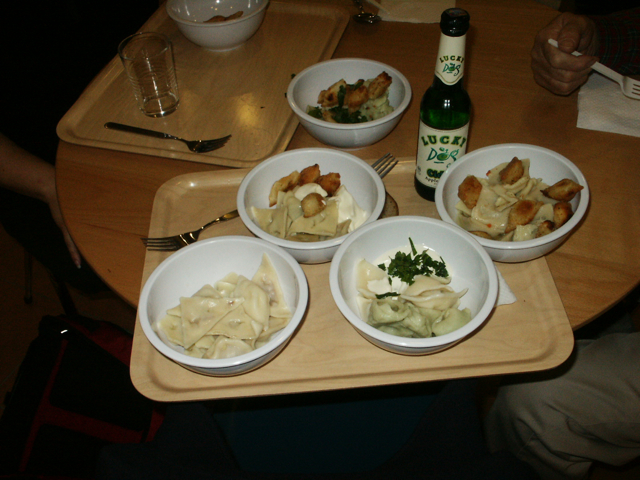
We stayed behind while the group went back to the hotel. It was a bit rainy, so we decided to check out the movie offerings at Forum Cinemas (http://www.forumcinemas.lv/?lang=eng, website is in English and films are mostly shown in their original language). We stumbled upon a free concert in the plaza in front of the center, Coca Cola Plaza. It was in honor of “2006: European Year of Mobility.” It was very interesting since some other countries in the EU are recruiting young Poles to work there. The concert was incredibly corny. I don’t know if not understanding the words made it better or worse. We got some dandy orange bracelets that we wore the rest of the trip to match our Ukrainian independence bracelets from Toronto.
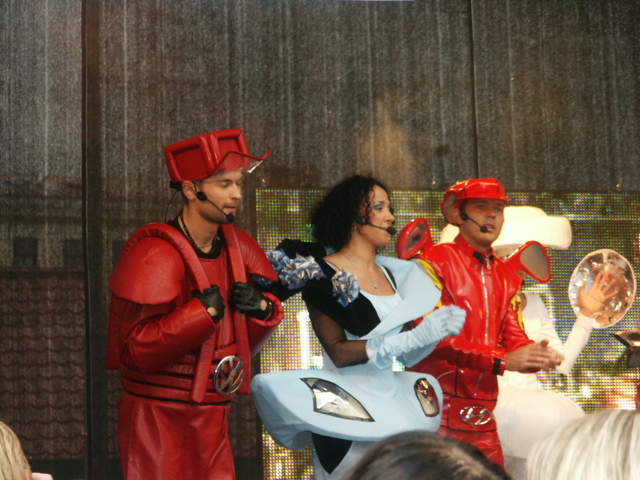
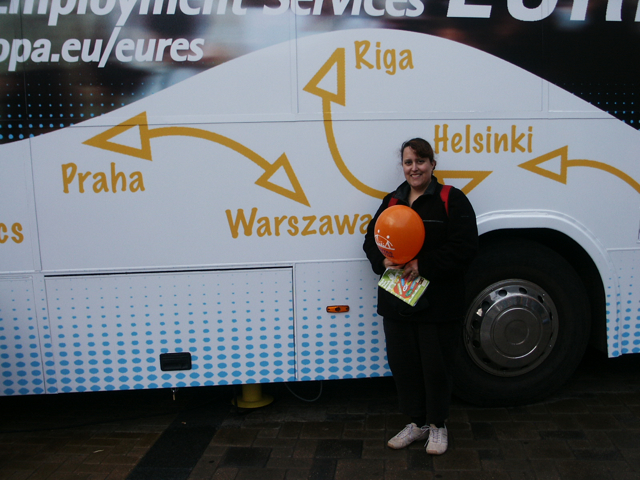
From there it was a pleasant walk through a park and back through the Art Nouveau district to dinner. While waiting for the group we attended a little bit of a candlelight service in a large church across from the restaurant. It was mostly young people chanting prayers seated on the floor in front of the altar. The old ladies at the back table were happy to scoop up our dollar bill donation (we had little Latvian money left since we’d be leaving in the morning). Group dinner was at a medieval type restaurant with a stone-arched basement. We had chicken kebab type things which were fine, but didn’t seem typical. Ice cream again for dessert, unfortunately, instead of delicious Latvian pastries.
4 October 2006
The road to Lithuania was rainy and cloudy. We passed a lot of great farmland, and a rest stop divulged that beets were one of the large crops. Our lunch stop was at a rest stop place with a mini zoo with a bear and ostriches. We had some tasty soup and beer. Late afternoon we arrived at our hotel, the Best Western Naujasis Vilnius. The hotel is on the north side of the river, which is a business district but only a 10 minute walk from the city center via a pedestrian bridge behind the hotel. Clean and comfortable rooms and very quiet. The biggest downside is that the dining room is much too small, and everyone is scrambling for a place to sit if the hotel is full. Breakfast has a good variety of things (the mystery snack items wrapped in foil are chocolate covered cheese – that’s right – cherry or vanilla flavored). There are quite a few shops in the area, and no shortage of strip clubs if that’s what you fancy (the area still seems quite safe as the strip clubs seem to cater to business men).
We walked across the bridge to the center and to the Museum of Genocide Victions (aka the KGB Museum; http://muziejai.mch.mii.lt/Vilnius/genocido_auku_muziejus.en.htm). People in our group paid $15 per person extra to be taken to the museum by the tour company. Some were a little envious to discover that in 10 minutes we’d taken a scenic walk there on our own, and it turned out that the museum was free that day for some reason anyway (it’s only a couple of dollars even when there’s a charge). Plus we were then free to explore on our own. Like the museums in Tallinn and Riga, this shows the sad history of the abuse of the Lithuanian people by the Nazis and moreover by the Soviets. The museum is set inside the former KGB prison. The upper floors have informational displays while the cells in the basement are left as they were, including the showers where prisoners were allowed their monthly baths (and the guards would taunt them by alternating hot and cold water). The basement also had a padded room to muffle the sounds of torture and an execution room. Excavations revealed rooms with tiled floors with a drain in the middle and a hose to wash the blood into the drain. One interesting exhibit is the KGB equipment room, showing how they tapped phones and spied on people.
It was getting late afterwards so our attempt to visit the Jewish Museum failed since it had just closed http://www.muziejai.lt/Vilnius/zydu_muziejus.en.htm. Another disappointment at the Church of the Holy Spirit, the old Dominican Friary where the basement contains a collection of preserved corpses from the plague and Napoleonic wars. They are no longer visible to the public since the exposure to elements decomposes the corpses, and they have no photos or information available in the church.
5 October 2006
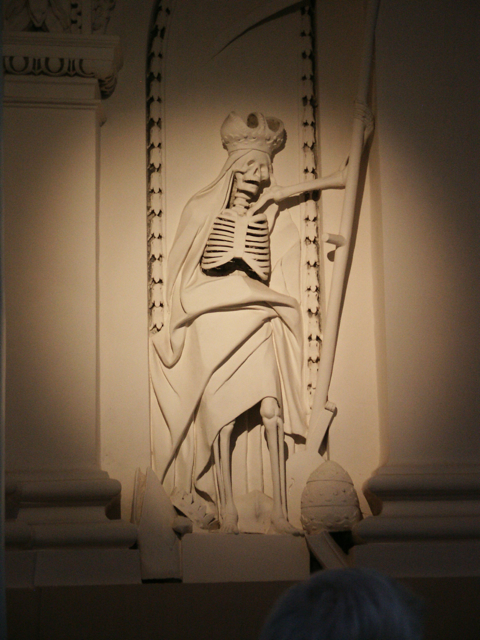
We had a city guide for the morning. The Church of Saints Peter and Paul was unique in that the ceiling and most of the walls are white, almost like someone forgot to paint them. The ship shaped chandelier was different and beautiful. The remains of St. Kazimierz are in a silver coffin in a side chapel along with large paintings, including one depicting his exhumation when it was discovered that his body was uncorrupted. The relics are surrounded by many ex-votos. We visited more churches and stopped for a panoramic photo opp, where we saw young girls picking mushrooms on a nearby hillside.
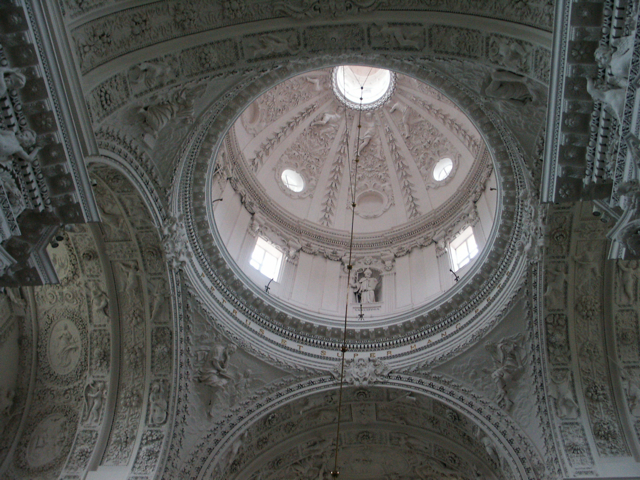
We bought a watercolor from a street vendor in the city center. It cost about $25.

That afternoon we wandered on our own to the town of Trakai. Again, some fellow tour group folks were impressed by our ability to take local transportation there (for about $3 round trip) while they paid $33 each for the tour (we didn’t go inside the castle, but there wasn’t much to see, and it was only about $3 admission anyway). It was a minor challenge to find the right bus, but more so because the Trakai official website misled us, and we would have fared better just figuring it out on our own (the website gave bus numbers which were irrelevant since they operate by platform number, not bus number). It is a longish (20 minute) walk to the castle from the bus station, but it’s pleasant and passes many shops, places to eat, and other tourist sites. The website has good information, but disregard the information about bus numbers. http://www.trakai.lt
Trakai is home to a small Karaite (Karaime) community, people of Turkic descent of who only a few hundred remain in the world. They were brought to Trakai in the 14th and 15th centuries by the Grand Duke to guard the castle. Their religion seems to be a form of reform Judaism, though in researching this there are some who describe the faith/ethnic group differently. It’s a bit confusing, but an interesting article can be found at this link http://www.smi.uib.no/paj/Harviainen.html. The temple/kenessa was closed, so we were unable to visit it. One of the main advantages to heading to Trakai on our own was that we could stop for our own lunch for a Karaite meal. We went to Kybynlar Restaurant, which has an outside terrace that looks like it’s probably a lot of fun in high season. Inside has some decorations related to Karaite. http://www.kybynlar.lt/index.php?action=kybynlar.content.viewitem.12&lang=en
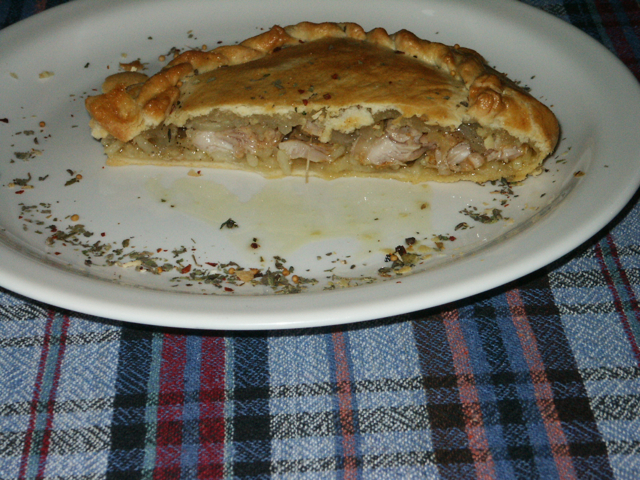
We ate kybyn, which looked exactly like and tasted quite a bit like empanadas! We also had the Karaite specialty, kiubete. Long Duc Dong in “16 Candles” would describe this as “interesting food fit neatly into round pie” (which is how the Donger described quiche). This had meat, spices, and a little rice and was delicious! This was also our first taste of warm beer, not warm in the regular European sense but as it heated up, and with honey, Karštas alus su medumi. We also had Sidras Kiss, a hard cider which was sweet and good. Good food and very good value. We visited the small Karaite Ethnographic Exhibition and had to summon someone to let us in. The museum is small but interesting and only 4 Lt. admission. The highlight of the town, of course, is the large castle. Surprisingly, the Soviets financed a sloppy renovation in the 1960s where you can see how they used new style bricks that don’t really mesh with the originals. As if to snub the Soviet legacy, young Lithuanian entrepreneurs line the walk to the castle trying to get you to give them money by playing plastic harmonicas and similar forms of entertainment (all young boys, about age 9). By paying 1 Lt. I was able to borrow an old Soviet fuzzy hat for a photo in front of the castle.
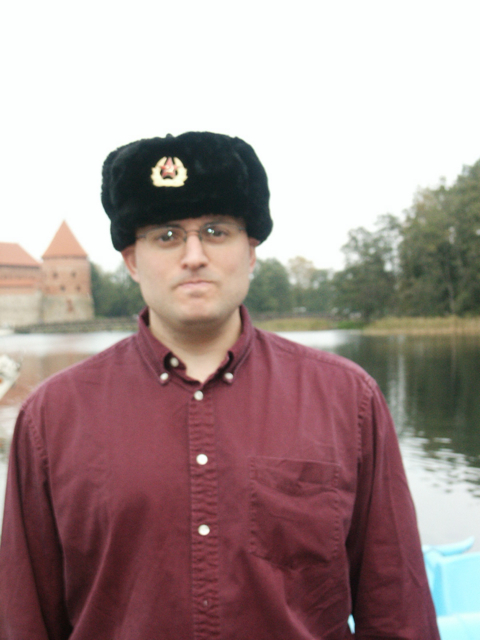
From the castle it’s a short walk to the unmarked Karaite cemetery (you must have a guidebook like the Bradt Guide that marks where to turn, or else after the bridge take a left onto a residential road. The houses along the way to the cemetery are well-maintained. It appears that under the Soviets people were able to keep their private homes (as they did in Poland and Romania).
We stopped at a branch of the small AJ Sokolades chocolate shop. I had a cup of hot chocolate, which is basically just thick, melted chocolate with a small cup of water to wash it down. Annabella just had some homemade chocolates, which were very good. http://www.ajsokoladas.lt/index.php?lng=en . There were some locals in there with a huge plastic bottle of what appeared to be their own liquor to spike their drinks with.
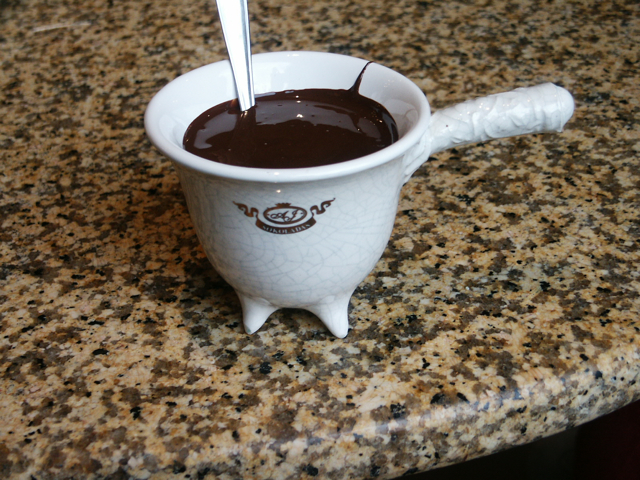
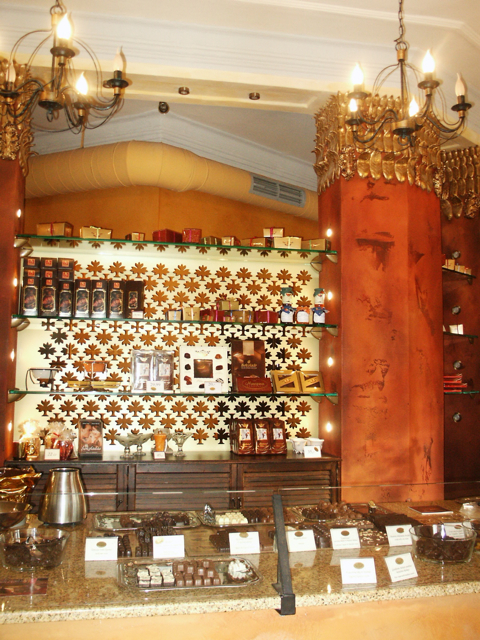
Our bus back to Vilnius was not exactly the express, but we did make it back just in time for dinner with the group. En route we stopped at the Gates of Dawn (Ausros Vartu), where the bridge houses the Madonna of Mercy icon. There was what appeared to be a small wedding taking place, with everyone dressed in black and white. The priest was very young. Dinner was at Gras’as, a gnome-themed restaurant (well, gnome statues prop up some of the tables, and it’s all very woodsy and odd. We were wishing for better food.
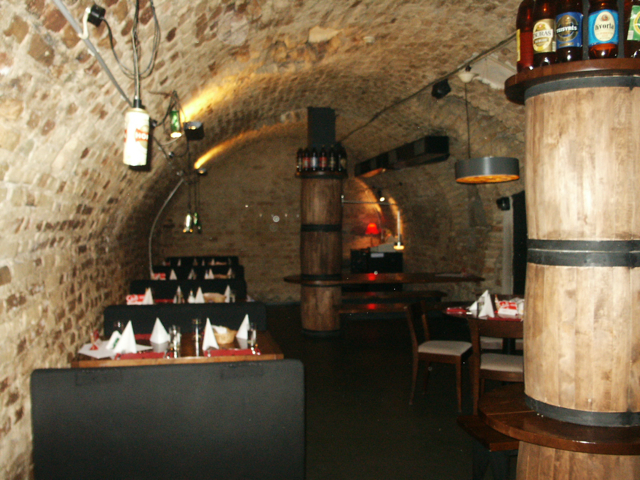
We walked home in the rain with tired feet but in need of the 24 hour pharmacy on 27 Gedeminas Street for some aspirin. We also stopped at the IKI Supermarket, a local chain, to get some bus snacks. Gedeminas Street is a nice shopping area with some moderately priced and many high scale shops as well. Of course McDonalds is there (though I must say we’re thankful for the one near the bus station since we really needed the WC there).
6 October 2006
Long bus ride to Poland with a rest stop at a touristy and relatively expensive restaurant. However, by American standards the prices were fine, and the soups, bread, and beer were good. Soon upon arrival we walked to Warsawa Centralna train station to organize tickets for our independent stay. The Radisson SAS Hotel is terrific! Warsaw is a big city, and we wanted to be walking distance with the central train station, so this hotel worked out really well for us. The rooms are super clean, lovely bathroom, cosy linens, quiet, comfortable. They have “themes” (Italian, Scandinavian, or Maritime). We stayed in Scandinavian, and it did remind me of a hotel in Rejkavik. Service was excellent, and the front desk staff looked up train schedules and printed them out for us, gave us maps and directions, and were overall friendly and reliable. Our tour guide wrote down basics for us on a slip of paper to present to the ticket people at the train station (e.g. 4 one way tickets, 1st class, non-smoking, destination Gdansk, day/date). The dinner buffet was probably the best group meal we had all trip (not that the competition was stiff), if for no other reason than we had some choices. The swimming pool is very nice with a domed ceiling painted like the night sky. There’s also a jacuzzi as well as a dry sauna and steam room. They have lockers to put your things. The fitness room looked great (we didn’t bring workout clothes but looked inside). As in other countries we encountered Germans taking off all their clothes.
7 October 2006
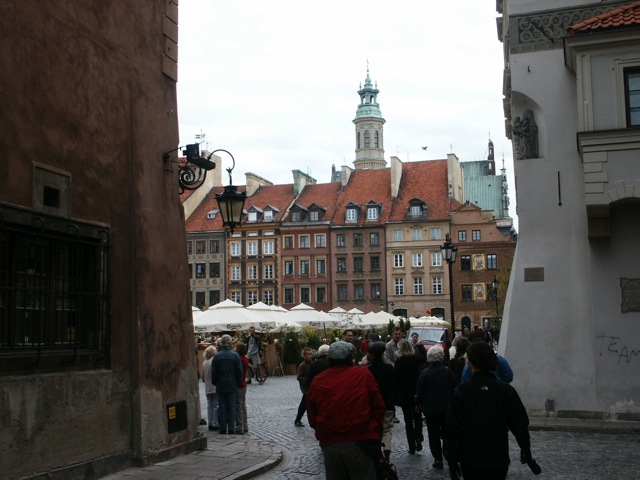
Radisson’s breakfast buffet has a good selection and something to suit all tastes (including an omelette station). The quantity is better than the quality, but no big complaints.
Since Annabella had been to Warsaw before, she took a daytrip on her own to Lodz (pronounced Woodge), Poland’s second largest city (train fare 52 PLN r/t, 2nd class). If traveling on a weekend or at peak times, it would certainly be worth the upgrade to first class because the train was really crowded, and it stretches the imagination to think where you might put luggage. Also, Polish trains have yet to go the all non-smoking route. It was a flashback to the bad old days of backpacking in the 80s. Since the cars are ½ smoking and ½ none, even with compartments you can smell the smoke from the other side. No leg room, either. Piotrkowska, the main drag in Lodz, is about a seven minute walk from Fabryczna Station (warning, the bathroom at the train station is 2 zloty, and like all Polish WC attendants, the lady in charge is MEAN). Piotrkowska was rather quiet on Saturday morning. Annabella walked up towards Plac Wolnesci. There seemed to be a museum at #2 not in the Lonely Planet guide with on a exhibit on Katolik Lodz (Catholic Lodz), but there wasn’t enough time to see it at the end of the day.
Having learned from previous trips that it’s best to see the sites you really want to see first, this lesson turned out to be valuable since the Historical Museum of Lodz, or the Poznanski Palace at Ul. Ogrodowa 15 closes at 2:00 on Saturdays (it said so in LP, but one doesn’t always pay close attention; http://www.muzeum-lodz.pl/angielski.html, admission 7 zloty). The Poznanskis were wealthy Jewish textile magnates. There are almost no signs in English, but near the entrance is one large historical sign in French (no mention of the fate of the family, which I also couldn’t find much online except to say that they had sold the house after WWI and that apparently at least a few descendents survived the Holocaust) . It is a beautiful Art Nouveau home with woodwork, ironwork, furniture, and many decorative items including two beautiful lady tiles in intricate nouveau iron frames. Arthur Rubenstein was born in Lodz, and several rooms feature his life and memorabilia with recordings of his music playing in the background. There is also a display of Polish literature, including letters from Czeslaw Milosz when he lived in Berkeley. The museum basement has super clean WCs and an exhibit on Lodz history plus some temporary exhibit space.
With the pace of building so fast through Poland, Lonely Planet failed to include the incredible structure next to the museum, built in the old textile mill: the Manufaktura complex (http://www.manufaktura.com/EN/zapraszajaNas.asp). It’s hard to know how to describe this place: museums, shops, Cinema City, restaurants, sculpture park, and in 2008 a luxury hotel). Annabella settled on eating in the food court because it was all non-smoking (quite a novelty!). She was tempted to eat at Flunch Bistrot (fun lunch??) but went to Solo Pizza (http://www.solopizza.pl). Luckily mushroom is her favorite because they didn’t have an English menu, no one spoke English, but there was a pizza called “funghi” (Italian for mushroom) and luckily the pizza actually fit the name. It was a good crust, decent sauce, plenty of fresh mushrooms. The pizza could feed a couple of solos and cost about $3 for an entire pizza. Throughout Poland the pizza toppings are very generous. She did get a scoop of ice cream at Flunch for 1.20 zl, or about 30 cents, and it was pretty good. She forgot to use a bathroom at Manufaktura and didn’t feel like paying 2 zloty to use the WC at the train station (there are no free train station bathrooms in Poland) so had to brave the train WC (not fun, but not awful).
Back in Warsaw, we had a knowledgeable guide named Isabella, who like many Poles we met told us about the suffering of the Polish people and their disdain for the Russians. We visited the Tomb of the Unknown Soldier, the Garden of Baths and Chopin’s Monument. Annabella’s mom had her first of several encounters with rude WC monitors, who practically assault you for your two zloty. We had no small change, so the rude woman took our U.S. dollar bill without offering any change (we should have gotten a zloty back). Lunch was some slightly gristly and not very tasty pierogie at an unmemorable and slow place. Our tour friends had splurged on lunch at the famous Fukier restaurant, where Annabella had been lucky to eat a delicious meal 5 years earlier with a fellow American traveler who treated her courtesy of his company’s expense account. Curiously, Fukier’s credit card machine wasn’t working that day they claimed, I lent our friends almost all the cash I had so they wouldn’t get stuck doing the dishes. It was Saturday, so we walked into a couple of weddings at churches along the way.
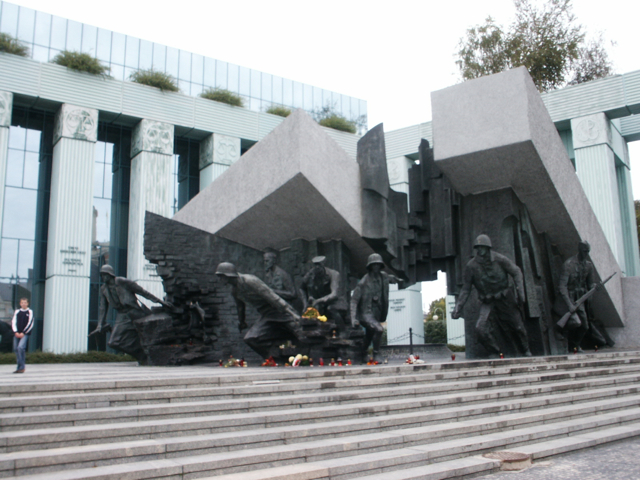
Polish television has this strange custom of dubbing foreign language shows and movies into Polish but leaving the original language low in the background. They don’t have multiple voices, just one announcer who reads all the parts in a somewhat monotone (regardless of the gender). Movies at the cinema are always subtitled, so it seems a little odd that tv operates this way (but at least if you’re desperate for English, you can strain to hear the original voices).
Dinner was at a small local place just a few blocks from the hotel. The menu was translated into English, but there weren’t any other tourists, and it was filled with locals. Pierogies were decent, good borsch and forest mushroom soups, very yummy apple sauce pancakes with cream, and Freeq beer (which is more like a hard cider and comes in different flavors; we had the raspberry-cherry).
8 October
Our group tour is over, so now we were on our own, me and my wife and my in-laws. Another good Radisson breakfast and made ourselves little sandwiches to eat on the train. Centralna Station is about a 5 [long] block walk. The escalator in the station was broken, and of course there was someone offering to carry our luggage down for a price.
We were wise to pay extra for first class tickets because the train was very crowded. We were prepared for a long and boring ride to Gdansk, but we heard a guitar in the next compartment and singing in English. Annabella went over to ask if she could sit and listen, and she got to talking to the guys in the compartment, Brian Allan and his manager Bernhard. Brian is a Scottish man living in Poland for many years, and Bernhard is his German-Canadian manager also living in Poland for a long time. They were on their way to Gdansk for the Yach Polish film awards (http://www.yachfilm.pl/?id=yachfilm/index), where their video “I Still Love You” had been nominated for several awards. They were traveling with Brian’s pal, dog Rocky, who will be featured on the cover of the new Why Not album. Brian was preparing to go to the Vatican on October 22nd to perform a concert for the new Pope in honor of John Paul II, a duet with Edyta Gorniak (a top Polish pop star). They were trying to decide between a couple of versions of a song, so we offered our opinion on which version we preferred. We had a good conversation about life in Poland and the overwhelming pace of change there.
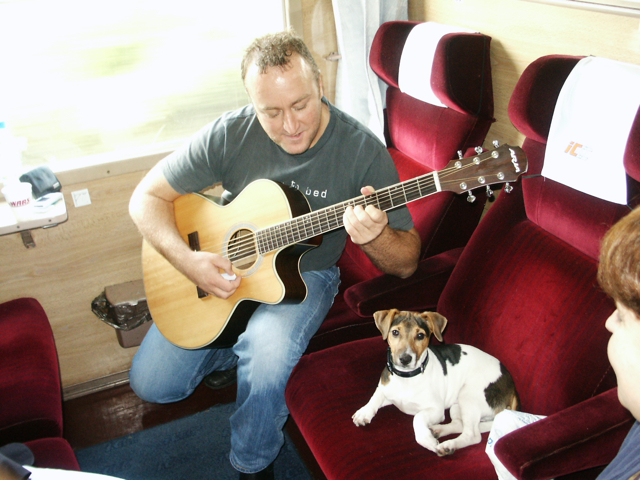
LP guide did get it right that there is a terrific view of Malbork Castle from the train. The tracks are actually very close to the castle, but we couldn’t get a good picture because there was a train approaching on the opposite track right at the best photo spot, which blocked our view.
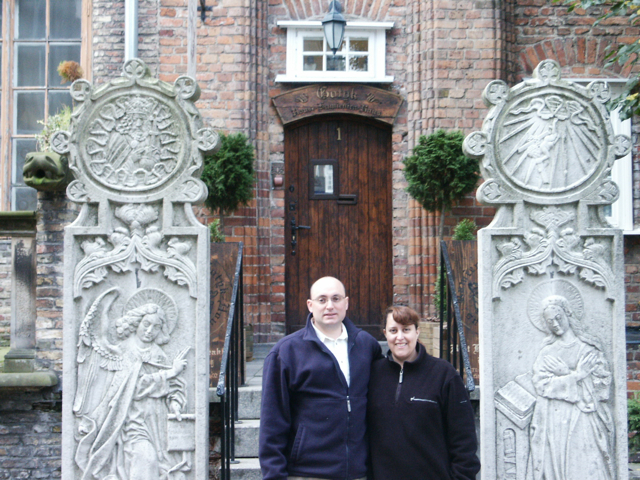
We got a taxi for the quick ride to Mariaka Street and our wonderful little hotel, Gotyk House (http://www.gotykhouse.eu/uk.html). Mariacka is mostly a pedestrian street, so we were dropped at the end of the block (the wrong end, unfortunately, but it is a short street). All the guidebooks are right that it is the most picturesque street in the city. They have 4 rooms now but will be expanding to 5 and adding a breakfast room in the near future. Our rooms were sparkling clean and tastefully decorated with Ikea and similar furniture and accessories. There are angels and other decorations throughout to make you feel comfortable. Our towels smelled wonderfully fresh, and our linens (especially the duvet) were very cozy. We had one small room and one larger room (the small room is small but very comfortable). The rooms were very quiet. Good water pressure in the shower (never to be taken for granted in Europe). We were also really excited to see a huge display of our hotel along with a smaller photo in the “Gdansk Houses” exhibit at the Uphagen House Museum. It is the oldest tenement house in Gdansk (though moved from its original location). Gdansk accommodations (as in the rest of Poland) are a poor economic value, but you will surely not do better in this price range for the location and the quality. If we were to return to Gdansk we would not stay anywhere else. Upon arrival you must ring the bell, but then you will have a key to let yourself in and out.
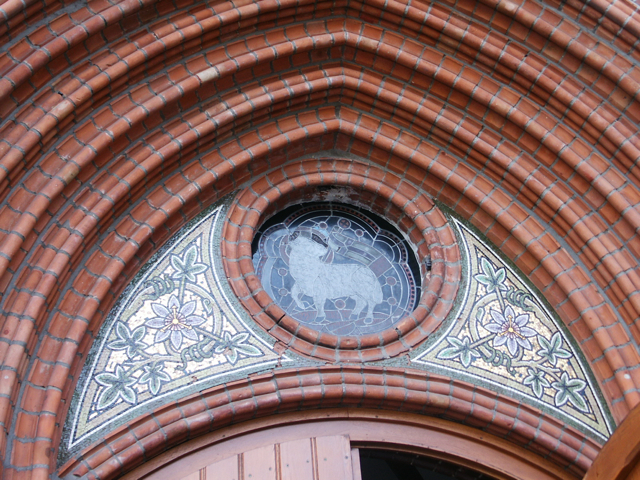
Our first sightseeing stop was St. Mary’s Basilica, directly across from our hotel and one of the largest brick churches in Europe. Only the roof was damaged during WWII, and most of its treasures had been dismantled and hidden away during the war. Later we walked along the Motlawa River and then over to Dlugi Targ, the main street. We tried to get a bottle of water from a shop on Dlugi Targ but came across the European phobia of accepting “large bills” for purchases. In this case, we were refused a 2 zloty purchase to be paid for with a 10 zloty note (the equivalent of a $3 bill, and the smallest paper note they make).
Gdnask is Amber City, and we bought a few small pendants to give as gifts. Amber prices are all over the board – you can buy a small gift for $5 or you can spend thousands. We were told that ambers popularity rose about 70% after the movie “Jurassic Park” came out. Even during Soviet times there was amber production and export.
Dinner at Pizzeria Napoli, right in the heart of the old town (http://www.napoli.pl/). No smoking!!!!!! How happy we were to eat in peace and being able to take deep breaths. The risotto frutta di mare was not good (regular rice, not risotto), but the soup was good and the pizza was very good. They have a wide variety of pizza, a menu in English, and very fair prices. There was old 1970’s Italian music (and some more contemporary) playing in the background, and it reminded me of Sunday mornings at Mom’s listening to old songs on the a.m. radio program.
We freshened up at the hotel and then had a long conversation with Andrzej, whose family owns Gotyk House. Our rooms were a little cold, and he explained that they have central heating not yet turned on by the city (though they do pay for their own consumption – the next day we had nice new space heaters in our rooms). We talked politics, history, future of the EU, etc. Of course we’re always ashamed by how well-educated so many Europeans are about the world while most Americans rarely even speak another language let alone know anything of world affairs. Feeling youthful, we walked down the block to Cafe Kamienica (ul. Mariaka 57/59). We tried the local Goldwasser Vodka (read about Polish alcohol here: http://www.krykiet.com/poland_beer_vodka.htm) . Legend has it that the Neptune Fountain on Dlugi Targ once spewed Goldwasser (including the gold flakes, I presume). It’s really more of a Sambuca/anise type of drink than it is a vodka. Kamienica is a great little pub/café. In the off season we were the only tourists, and the place was filled with local young people having a good time. They have some tables and some comfy stuffed chairs and loveseats (truly loveseats as there was a couple making out in an upstairs corner). We stayed on a loveseat in the quiet downstairs, which was also less smoky. Annabella tried the apple juice and vodka combo that seems to be quite popular. The streets are beautiful at night when lit, and St. Mary’s is especially beautiful.
9 October
Kasha, the girl who works at the hotel, brought up our breakfast – she’s very thin, probably from carrying trays up and down all those stairs every day. We walked to the train station by way of several colorful neighborhoods. We stopped at the 16th century Old Town Hall (Ratusz Staromiejski), and no one stopped us or asked for money, so we walked upstairs. The upstairs foyer is partly assembled from old burglars’ houses, including walls completely tiled with original, hand painted Delft tiles. We saw the Great Mill building across the way, which now houses a modern shopping mall with many small stops/stands. There’s also another old, red brick hall with a mall across the street, but we’re not sure of its history. We bought some pastries (not too good) in the downstairs, which was interesting for its display of some archaeological items found presumably during construction of that building.
We visited St. Bridget’s Church, 700 years old but nearly destroyed in 1945. From photos in the entrance it seems that there ways a fire in May 2006. Later research revealed that there was a fire on 22 May that destroyed the roof (which was being repaired), so the church was closed for worship. Lech Walesa had been a regular there. The astronomer Helvelius (whose monument is nearby) is buried in the church, but we couldn’t see his tomb since only the entrance was currently opened. Since we had run out of room on our memory sticks, we stopped at the shopping center to buy a new compact flash card, at a similar cost to in the states.
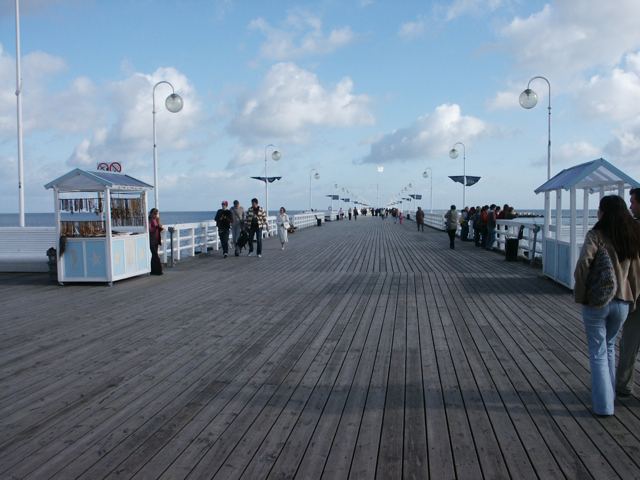
The commuter train to the seaside resort of Sopot cost 2,80 zloty per ticket, which must be punched at the station before boarding the train, like in Italy (though all day long we never once saw a conductor checking tickets, sort of like in Italy, too). It was about a half hour ride, and the center of town was a short and pleasant walk from the station. We were blessed with excellent weather, sunny and warm. We got the sense that this must be a really fun place in summer. Nuns from our train dogged us all day throughout the town, even getting ice cream (lody) when we did. Poland has regular scoop ice cream but also has very popular twisty soft serve cones. Annabella had one in Lodz that was so tall that some of it had to be thrown away, but our Sopot lody wasn’t so high.
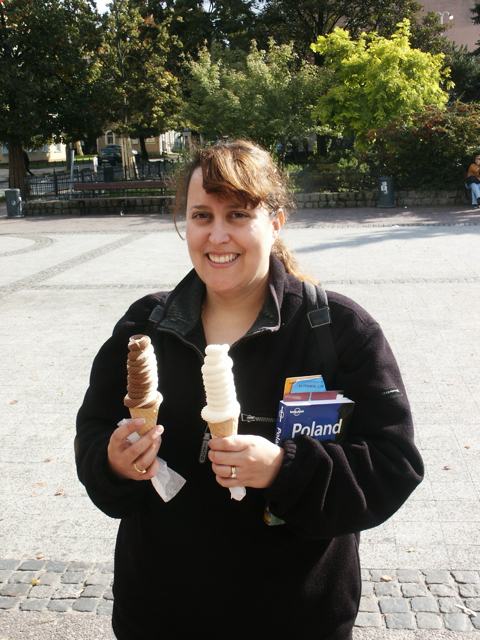
Sopot has lots of shops, restaurants, and bars as well as Europe’s longest wooden pier. We tried to find a place to eat along the beach, but most places had already closed for the season. There’s not much to do in town other than just relax and enjoy the atmosphere. For lunch Annabella had a flounder that was described as “fresh off the pan on onto the plate,” but which was very fishy. My sander fish (a fleshy white fish) was very tasty. We went on to Gydnia (part of the tri-city). It was not at all charming and really not worth visiting unless you have a particular interest in visiting any of the waterfront attractions (which include an aquarium, museum ships, cinema). The train back was 4 zloty.
Dinner turned into the usual Cavallo curse. We had been told of a wonderful restaurant, but we couldn’t find it. Andrzej came out to help us find it, but there was a sign in front that it was closed for some kind of repairs. The sign said to visit their other restaurant, Sphinx (part of a successful Polish chain that recently had an IPO), and that we could order from the same menu. Sphinx had no idea what we were talking about, and their regular menu is kebabs, burgers, etc. Luckily we left because we then went to Elephant Café, also on Dlugi Targ. Parents were cold, so we went inside and had a private room in their basement, which has a fun and funky décor with comfortable red furniture (and yay for no smoking – no one else there) – some nights they have live music because the next night we stood outside eating our lody and enjoying a pianist. We had the best waiter in Poland, Martin, who was so friendly and helpful and ran up and down the stairs to take care of us. This was the best zurek (traditional soup with egg) we had all trip, with lots of tasty sausage. I had beet soup and bigos, a meat and cabbage all fried together dish that was actually not really appetizing, though it was obligatory to taste it at some point in our trip. Dessert was a homemade apple-stuffed cake with cream and ice cream that was really delicious.
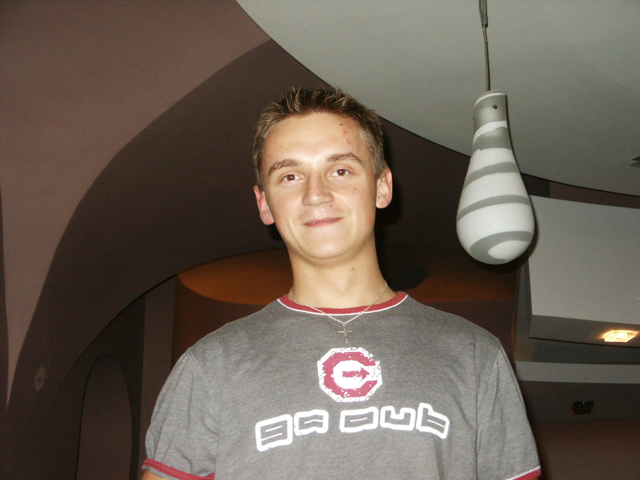
We went to Cinema City for a late movie (http://www.cinema-city.pl/). There’s an inexpensive Internet Café on the bottom floor with reasonably good connections and friendly help. Polish cinemas still have a reserved seating system, which has its pluses and minuses. We saw “World Trade Center,” in party because we had wanted to see it, in part because it was one of few options in English, and in part because we wanted to observe the audience reaction to this movie in another country. We didn’t have anyone sitting in front of us, so we didn’t get to gauge any reactions.
10 October
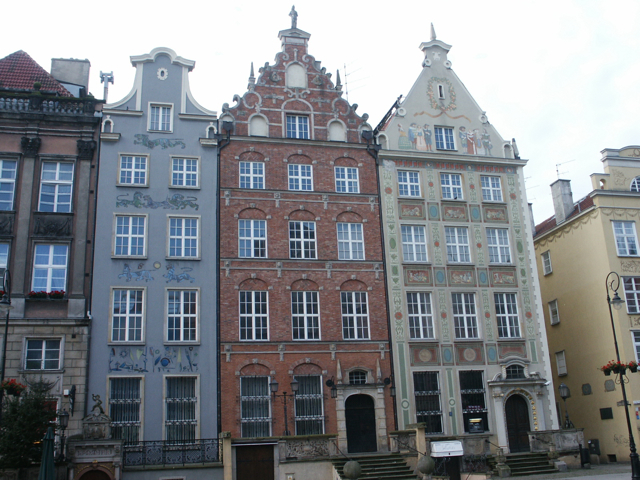 Busy day of city sightseeing in Gdansk. As luck would have it, Tuesdays are free admission to many Gdansk museums (at least in the off season), with the only disadvantage being that in order to control crowds people are only admitted on the ½ hour (not a big deal at all, though, especially if you’re willing to wait about 15 minutes). We visited the brand new Amber Museum, located in the old tower. The museum was much larger than we expected and really well put together. There is a history of amber and scientific information along with many pieces of amber jewelry and other treasures. You must be careful not to get too close to anything or a LOUD alarm will ring (er, we’re not admitting to anything). Here’s a great link to Gdansk amber information, including a link to the museum: http://www.gdansk.pl/en/article.php?category=453&article=924&history=
Busy day of city sightseeing in Gdansk. As luck would have it, Tuesdays are free admission to many Gdansk museums (at least in the off season), with the only disadvantage being that in order to control crowds people are only admitted on the ½ hour (not a big deal at all, though, especially if you’re willing to wait about 15 minutes). We visited the brand new Amber Museum, located in the old tower. The museum was much larger than we expected and really well put together. There is a history of amber and scientific information along with many pieces of amber jewelry and other treasures. You must be careful not to get too close to anything or a LOUD alarm will ring (er, we’re not admitting to anything). Here’s a great link to Gdansk amber information, including a link to the museum: http://www.gdansk.pl/en/article.php?category=453&article=924&history=
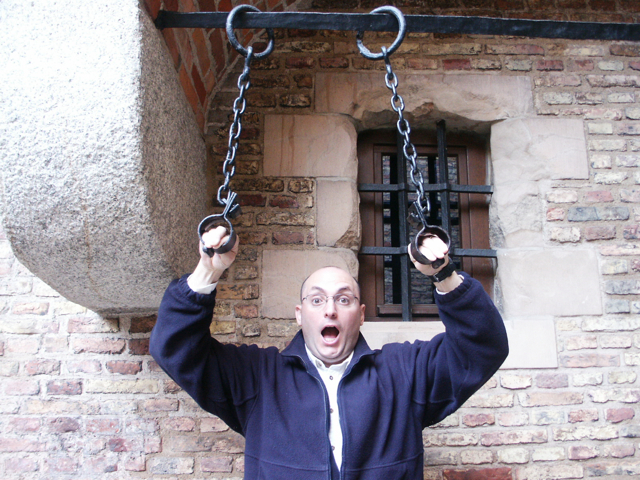
The Uphagen House Museum demonstrates how houses looked before the war (this is where we saw our Gotyk House Hotel’s building featured). The house has other exhibits and house history and is well worth visiting. The Town Hall Museum is also interesting and has many ornate rooms, including the Red Room, which had been dismantled before the war and hidden. This museum had some very dramatic photos of the destruction of the city.
We scurried back to St. Mary’s to see the noon tolling of the historic clock. It was likened to the big clock in Prague’s Wenceslas Square, with puppets and animation. Clearly we weren’t the only ones whose guidebooks told of this since other tourists were waiting intently in from of the timepiece. Around 12:10 we all decided that the clock was no longer functioning and left.
As luck would have it, this day was the 80th anniversary of the Economic College (though the museum next door was closed as a result, and it had been at the top of our list of places to see). We opted for lunch right next to the Neptune Fountain so that we could enjoy the band and other festivities for the anniversary celebration. Watching the cheerleaders with their pompons was a flashback to the 1980s (we had been skeptical when someone said they were 20 years behind on everything, but this made a good argument for that statement). There was a weird performance art piece that consisted of whale music and performers in flowing costumes walking on stilts. Lunch was okay with some steak and butter.
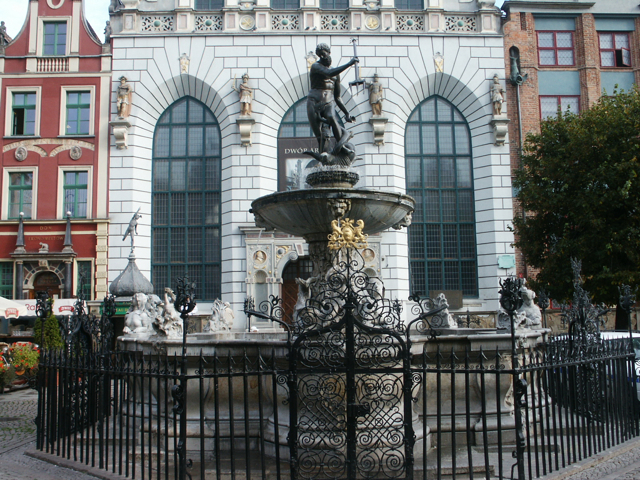 Post lunchtime was reserved for a walk along the Motlawa River to see the Crane Museum, although we were too late to go inside, of course. But the most interesting part of the crane, the giant wheels, could be seen without entering the museum. We had decided to walk the mile plus up to the shipyards where the Solidarity movement was founded. Luck was on our side as a kind Polish man offered us a ride on his boat for 15 zloty each (just $5 for an hour ride). We hesitated for a minute uncertain if he’d said 15 or 50 zloty, but what luck that we went ahead with it!
Post lunchtime was reserved for a walk along the Motlawa River to see the Crane Museum, although we were too late to go inside, of course. But the most interesting part of the crane, the giant wheels, could be seen without entering the museum. We had decided to walk the mile plus up to the shipyards where the Solidarity movement was founded. Luck was on our side as a kind Polish man offered us a ride on his boat for 15 zloty each (just $5 for an hour ride). We hesitated for a minute uncertain if he’d said 15 or 50 zloty, but what luck that we went ahead with it!
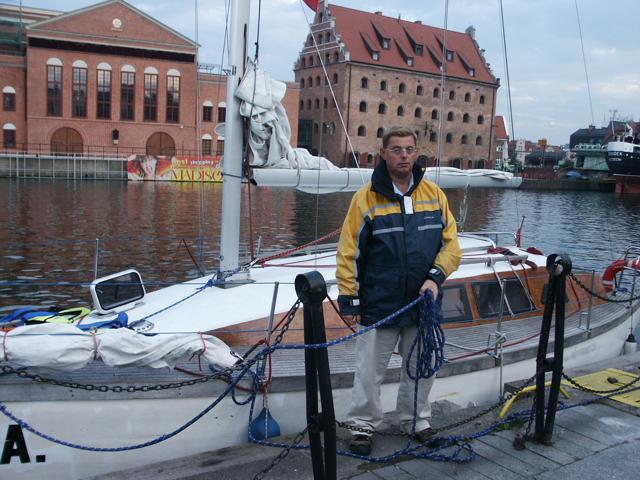
The weather was terrific, and we were so close to the ships that we could literally smell the wet paint. We saw a lot of oil ships, shipping containers, and repair work being done. Though the shipyard is well past its heyday, it is still an active and working site.
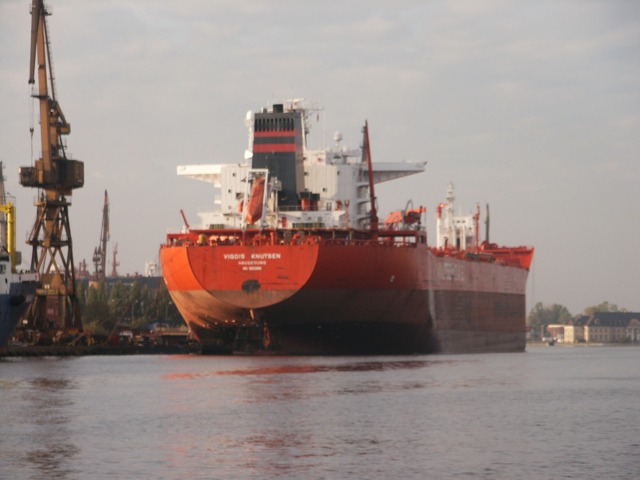
We had dinner at one of the many restaurants along the riverfront and at some delicious fish with butter and mushrooms, sausage, warm beer with honey, and Redd’s apple (hard cider).
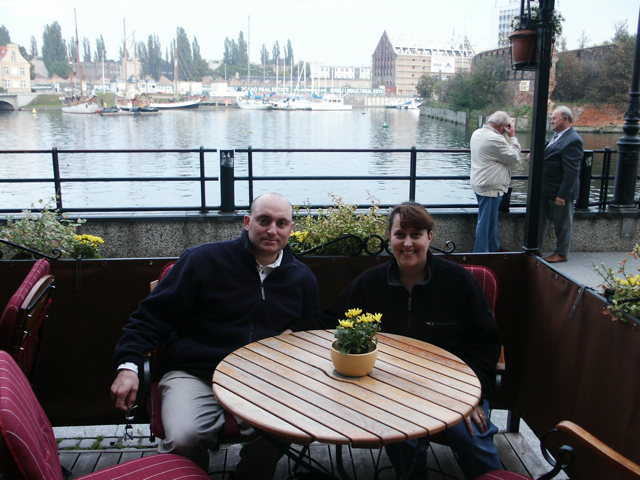
We met up with Andrzej from the hotel, who took us on a wonderful personalized walking tour of the city. It was our first time to walk to the other side of the river, where we saw the opera house, maritime museum, and some buildings destroyed during the WWII bombings that are still left in ruins (their future fate is uncertain). Back on our side of the river, we saw the site where the current owner of the Hotel Hansa struck a deal with the city to buy a piece of land for about $10 million, but repayable over 40 years. We also saw the Radisson building on Dlugi Targ where the new hotel is going up, but they must build around the existing buildings and incorporate them into the design, including anything they unearth as they dig. Andrzej wanted to show us the home of Fahrenheit, but the commemorative plaque was missing. We asked some local kids loitering outside a shop, and they pointed out the house to us. We finished the evening at a café bar with a cappuccino and a hot cocoa with cinnamon. We talked about politics and culture until the place closed.
11 October
Walked a little this morning to get water and also some Halls for Dad’s sore throat. We found a little shop not far from the hotel where we found everything at a good price and with friendly service. Breakfast this morning was excellent, with scrambled eggs. We said our goodbyes to our gracious hosts, who called a cab to take us to the train station (about $5 for the ride). We had to change trains en route to Torun, but the conductor was incredibly friendly and found someone to translate for us so we’d be sure to get the right connection.
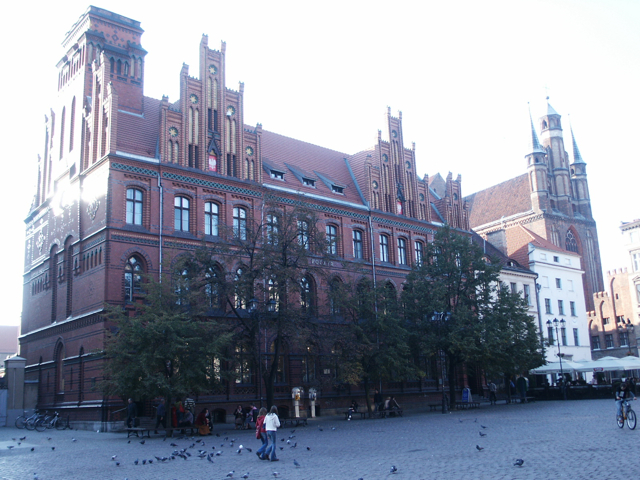
In Torun the cab to Hotel Spichrz cost 11 zl. The hotel is in the old granary, converted into a warehouse, converted into a hotel. The street is front was being renovated and new cobblestone was being laid down. Torun was also spared bombing during WWII and retains its original charm. It is buzzing with renovations, college students, children, and people walking about the town. We visited several churches and then went to get some gofry (waffles with lots of cream and jam, very messy but good and a wildly popular afternoon snack). Each one is a dollar or so, and people seem to love the Pod Arkadami across from the main square. It is a bar mleczny, or milk bar, which were popular establishments in Communist times to get cheap food. There aren’t many left now, but this one is still very much alive.
We hung out in the main square for a while eating our gofry and met some university students, who spoke excellent English, who invited us to a performance art piece that night in a basement theatre, a modern day spin on Julius Cesar. Post-gofry we continued our city walk and stopped in at St. James Church for a few minutes of mass and to enjoy the unique flying buttresses and frescoes. Quite a sight to see a man shoveling a huge pile of coal from the street into the basement of an apartment building, and so I guess it’s still the most common heating fuel source.
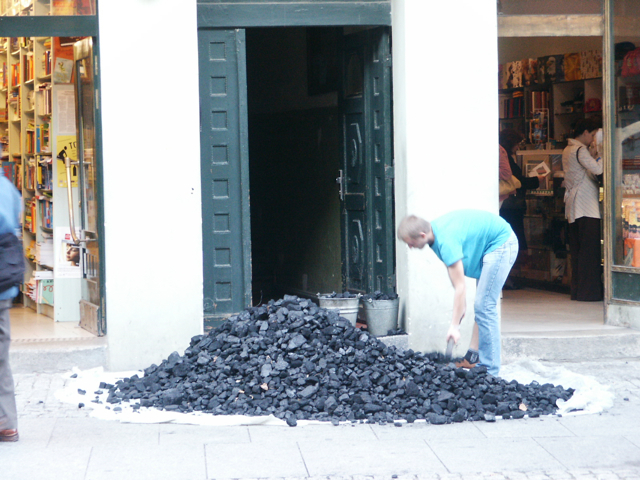
Back at our hotel we wandered around the dinner hall and banquet hall, which have a real lodge feeling with rustic wood and animal heads and a full taxidermied bear. Dinner was a very typical Polish meal, and were entertained by a 3 piece band of accordion, double bass, and violin playing traditional music. Our relatively expensive mushrooms and cream appetizer was exquisite, Dad’s pork ribs were great, the pierogies were okay, and my venison was okay. We were not fans of the lard with pork parts bread spread.
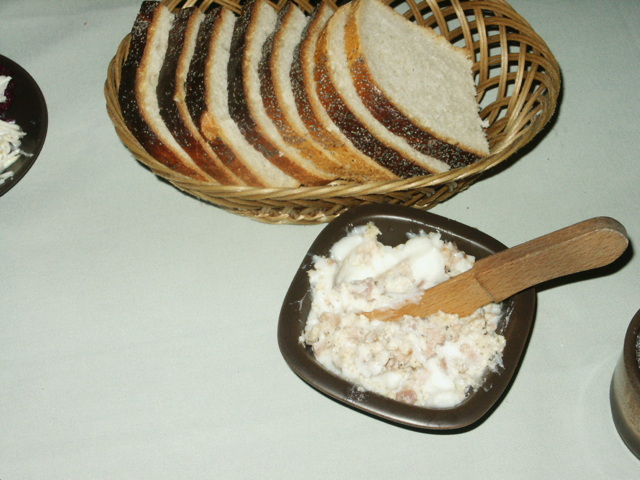
We headed off to see our Cesar play, but it was cancelled due to technical difficulties, so we wandered over to the Jesuit church, Church of the Holy Spirit, for an organ concert. The church was packed for mass and the subsequent concert. It was enjoyable and so relaxing that we almost fell asleep.
Post-concert refreshments were had at Pod Aniolem, a basement bar under the old town hall and very popular nightspot. Smoky, of course, but tolerable with some comfy love seats and eclectic furnishings. The young adults in there are civilized and enjoying their drinks, conversation, smokes, and funky music. We snacked on some chocolate-covered gingerbread and headed back to the hotel. Our hotel room was noisy until 11 p.m. from the banquet hall beneath our room, and the walls were quite thin. The man in the next room was snoring, and the couple in the room on the other side awakened us in the wee hours with their hotel aerobics – it sounded like they were in the bed with us.
12 October
Breakfast was fine but not exciting. The omelette guy didn’t show up until we were finished eating. Our first stop of the day was the Orbitarium. The Planetarium shows were sold out, so we joined a class of excited youth exploring some scientific exhibits, like a globe full of blue liquid that makes waves when spun around and a scale that tells you your weight on different planets. We seemed to be something of a novelty act to the children there, either because we were old or because we were American. We spoke in English to the girl wearing the “Minnesota University” shirt (where do they get this stuff??), and then she followed us around. The kids loved it when we spoke to them in English.
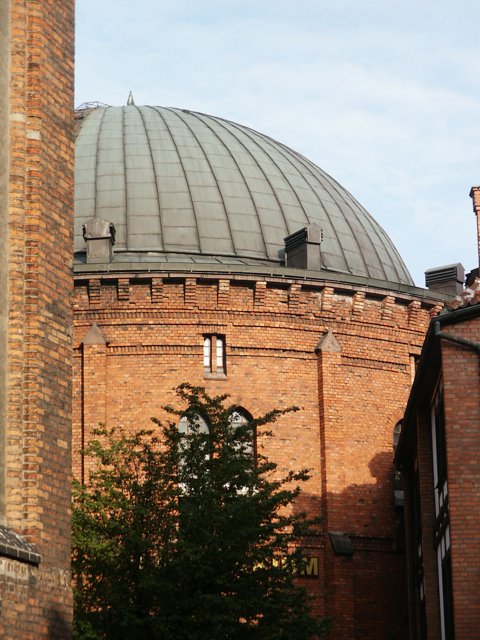
Our next stop was the home of Copernicus. Torun is the gingerbread capital of the world (since the 14th century), and we were sorely disappointed that the World of Gingerbread had no English tours available, and it’s not possible to visit without a tour. From there it was onto the House of the Eskens, with displays of ancient Poland, like wigwams and Neanderthals. I got scolded for touching a rock in a display. Downstairs had old maps, military weapons, and generic items from Esken merchant families. There was a temporary exhibit of student art work from 11-19 year olds that was very impressive stuff.
The Old Town Hall Museum has the history of Polish inhabitants and merchants, displays of an old fisherman’s hut, old burghers’ houses, and other things. Workers in this museum were not friendly, and apparently the no smoking rules only apply unless you’re employed by the museum. The art exhibits are beautiful, including works by some of the best known Polish painters.
Pizza lunch down the street from the hotel: cheap food, slow service, comfortable old booths with great stained glass windows on top of the booths, and plenty of smoke. A weird man with a black eye came in and sat in our booth and started talking. We just said “no zloty,” and he quickly got the message and wandred off to look for another donor. 2 pizzas, 1 beer, 1 soda, and 1 tea came out to 32 zl. ($10). The crust was good, and they brought us ketchup and mayo for on top the pizza! They are definitely not stingy with toppings like they are at home.
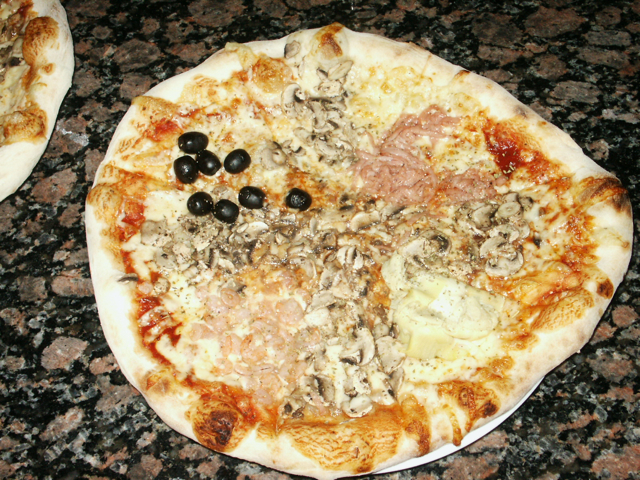
We took Dad back to the hotel and went to see Pirates of the Caribbean at Cinema City (Tickets 32 zl, about $10). We walked past the ethnographic outdoor museum, which was in down mode for the off season. We took some funny pictures outside the cinema. The cinema is quite new, very clean, with comfortable seats. Not many people go to the movies on weeknights. The screen is large with good sound, and it’s a pleasant experience.
After the movie we went for bad coffee and worse hot chocolate but in a pleasant area outdoors in the main square. We were in front of the statue of the violin player surrounded by frogs, which the kids pat on the head as they run around the fountain. We gave 3 girls some Hello Kitty bubble necklaces, which they thought were a lot of fun. Across the square is the Artus Hall, with a cool ceiling and paintings in the Arts & Crafts style. Inside the courtyard was a restaurant that looks new but in the old style, which we were sorry not to have discovered earlier.
Picked up some more gingerbread (pierniki) at Kopernik stop to bring home. At the ruins of the Teutonic Castle there were children playing soccer, and we gave them some toy light up sharks, which they liked.
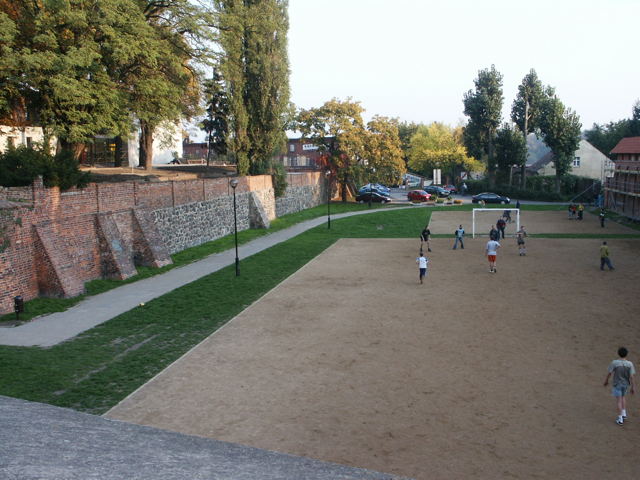
We were early for dinner at the hotel so there wasn’t any music yet. We had probably our best meal of the trip. The pork tenderloin stuffed with “mould cheese” (blue cheese) was outstanding, the ribs delicious, good soup in large bowls. We passed on the lard bread spread. We went for after dinner tea in the outside tables of Pod Aniolem and listened to the live guitar play in the bar across the way. It was a man singing “Killing Me Softly,” but he didn’t change the words, so he was singing, “killing me softly with his song….”
Torun has a great vibe – people are walking all around, and the large square is like that found throughout Europe and the center of town life. The city also feels safe. I guess we like college towns a lot.
Our hotel room was very noisy again, from the banquet hall, and from Grandmother’s Irish Pub across the street, and from the bedroom aerobics next door.
13 October
Misty morning, but a quick walk around the outer edge of the city took us to see some old granary buildings, including one where the windows are shaped like sacks of flour, and the Leaning Tower of Torun. Most of the city walls (the old prison, granaries, leaning tower, etc.) are now housing.
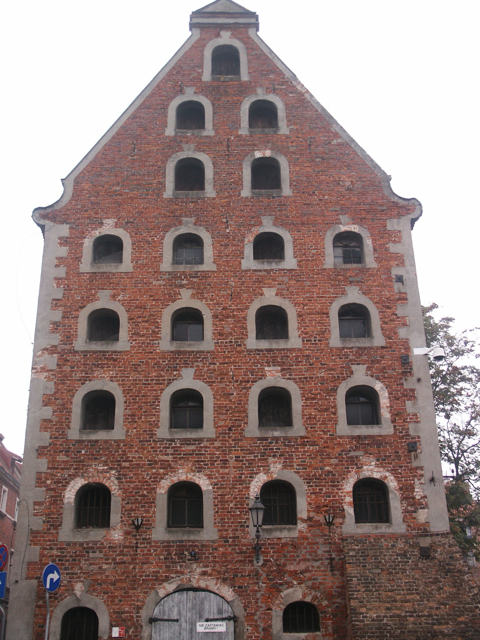
Mom was in hysterics as we tried to tell the taxi driver where we were going. Annabella found the word for train in the guide book, which is “pochunk” and sounds more Chinese than Polish, though the driver got the message.
The train was a bit cold, and the only non-smoking cabin had a young man sitting alone, Gregory. Poor soul had to spend the next 3 hours with us. Oh the humanity – haven’t the Poles suffered enough?! We talked his ear off and listed to him tell us about how his brother is a mason who works in Sweden now, like so many other Poles, where he makes about 7 times what he would make in Poland. He is from Wieliczka, where the salt mines are, and delivers cars from Germany to Ukraine. We offered him coffee, but he’s an anomaly among truck drivers who neither smokes nor drinks coffee.
Back in Warsaw we walked to the Westin from the train station and rode up to our rooms on the 17th floor in the glass elevators with a view of the city. The Warsaw Uprising Museum is about a 15 minute walk from the hotel. It just opened up in 2005, and is huge and well done. You could easily spend the better part of a day here. It’s 3 floors high and has many war-related exhibits, including a good children’s room.
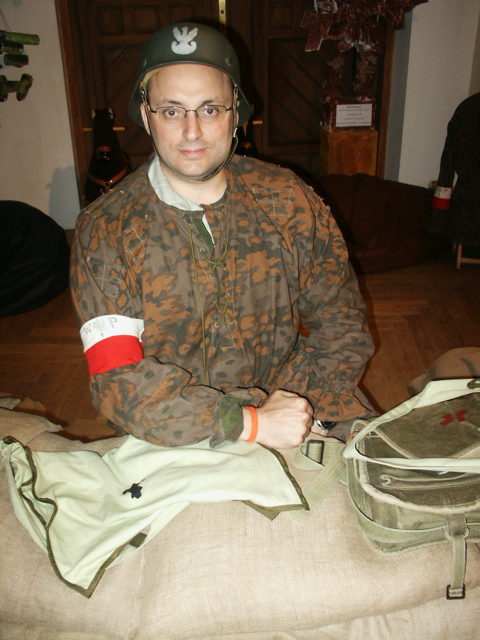
Some of the exhibit has cobblestone “streets” and is made to feel like the old city. There are recreations of tunnels, gravestones, videos, even a replica of the Liberator airplane (a British plane built in Texas). The museum café is done in Communist red with a tall hammer and sickle and 1940s music and furnishings. Outside the museum is a long black granite wall carved with the names of the 140,000 people lost in the uprising (120K civilians and 20K troops), which looks like the Vietnam Memorial. Admission is only 4 zloty (less than $1.50). Good website in English, too: http://www.1944.pl/index.php?lang=en&lang_time=1
Dinner was back at the Restauracja Hector, where we’d eaten the week before. We had a pork cutlet with fries, zurek, apple pancakes drizzled with chocolate, drinks and other things at a low cost and with friendly service. We were intrigued by a menu item translated as “cheese chops with bread crumps and tartar sauce”. Hmm. Mozzarella sticks? We’ll never know.
The Westin rooms are beautiful with comfortable beds and a great bathroom with a separate stall shower. The bathrobe makes me feel like a celebrity.
Our final morning in Poland we take a quick cab ride to the airport. We use the last of our zloty to get some cheese pancakes with vanilla syrup and a small bag of gingerbread. Now that liquids aren’t allowed on flights, we were unable to buy the 3 gallon bottle of kosher vodka for 293 zloty (about $95). We don’t have the kosher vodka, but we have our memories.
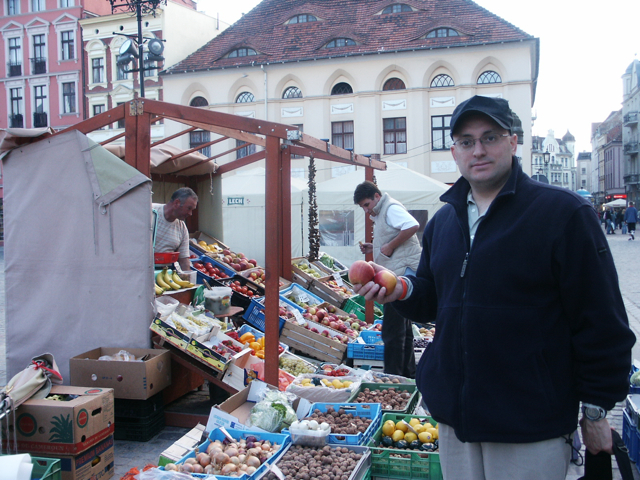
Some general thoughts on Poland/Polish people: Uwaga! That means “Warning!” and is our favorite Polish word. Their geographical location in between two aggressive neighbors (Germany and Russia) has been their curse. We were reminded that about as many civilians died every day during WWII as died on September 11th, and at least half of these were non-Jewish Poles. Poland lost more than 16% of its population during the war, the highest percentage of any country (followed by Lithuania, with 14%. The Soviet Union lost the greatest total number of people, but percentage wise it was less than Poland. Major cities were destroyed. They went behind the Iron Curtain after the war and lived under the oppressive Soviets until less than 20 years ago. This is a legacy just one or two generations old, and people have not forgotten (nor should they). While Germany hardly comes across as being their reconciled favorite next door neighbor, there seems to be less resentment and animosity there. The Russians are a different story. It’s not just the Soviets, it’s the Russians. And, honestly, who can blame them? Of course in the U.S. you can’t talk badly of anyone. We can’t call anyone the “enemy” because it’s politically incorrect. I’m glad that the Poles don’t forget their history. Keep an eye on your enemies. Was it Plato who said, “Those who tell the stories rule society” ?? We know that those who don’t learn from history are doomed to repeat it.
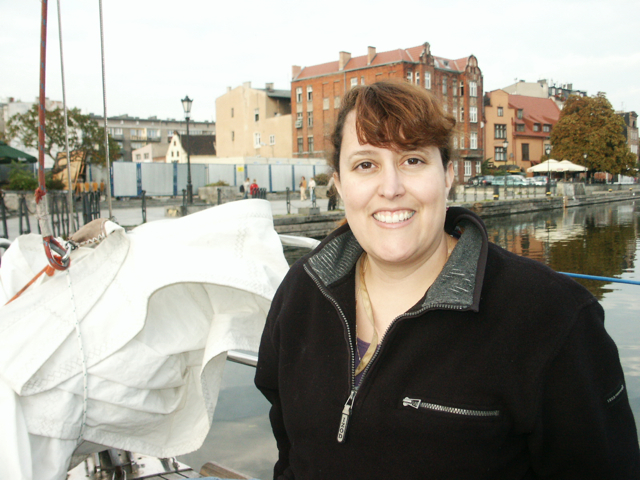
Annabella’s thoughts: I told a young Polish woman that I loved her country and that the people were so friendly. She seemed shocked. When I reflected on her shock I realized why she was so surprised to hear me say that. People on the streets do not smile (this is true of the Baltic States, too). Bostonians don’t much smile, either, come to think of it (I remember moving to Boston years ago and finding this striking here and then being surprised when visiting the Midwest at encountering the exact opposite of this, so you can’t blame it on the weather). It’s just that it doesn’t take long to get past this initial unhappiness. Polish people seem to genuinely like Americans (can’t say that about too many nationalities), and they are really interested in talking to you and getting to know you. They share information about themselves and especially about their country. We were on a train but needed to change trains in another city, and the conductor walked down the corridor until he could find someone who spoke English to translate this information for us. Most MBTA drivers can barely be bothered to open the door for you let alone go out of their way to help. Whether due to their history, the cold and damp, or something else, the Poles on the surface exhibit a general malaise, but they are kind, intelligent, curious, faithful/spiritual, and genuinely open to new ideas and not afraid of work. The rapid development during the post-Soviet era is a testament to these attitudes.